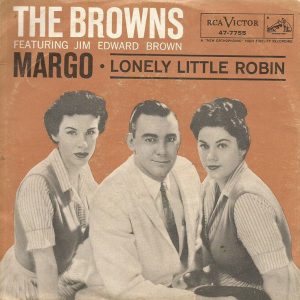calsfoundation@cals.org
Maxine Brown (1931–2019)
Maxine Brown was a musician known for her work with the country group the Browns in the 1950s and early 1960s. She had a brief solo career before retiring from the music business in the 1960s. While the Browns had several songs that sold a million records, Brown documented her frustrations with the music industry in her 2005 memoir Looking Back to See.
While she always called Arkansas home, Ella Maxine Brown was born in Campti, Louisiana, on April 27, 1931, to Floyd Brown and Birdie Lee Tuberville Brown. She was one of five children. Her siblings included two boys (Jim Ed and Raymond) and two girls (Bonnie and Norma). As a young girl, she moved with her family to Sparkman (Dallas County), though the family relocated several times before settling near Pine Bluff (Jefferson County).
Her father, who was disabled and a heavy drinker, worked in logging, and her mother ran a combination grocery store and restaurant. Brown endured an isolated and impoverished rural upbringing known mostly for hardship. In September 1943, her younger brother was killed by a truck as he was helping his father on a logging job. Maxine’s mother was eight months pregnant at the time. Her father later lost a leg in a logging accident.
Maxine Brown graduated from Watson Chapel High School in Pine Bluff in May 1950. Rather than go to college, she enrolled in a business school in Little Rock (Pulaski County). She was working in administration for the Arkansas State Police when the Browns got their first break on the Barnyard Frolic radio show in Little Rock.
The Browns—then consisting of Maxine and brother Jim Ed—had their first hit with “Looking Back to See,” recorded in 1954. The song—taken from a story told to Maxine by her younger sister about a school crush—went to No. 8 on the Billboard country chart. A version by Justin Tubb and Goldie Hill did even better, reaching No. 4 that same year. The song was later recorded by a slew of country artists and was one of the biggest hits of the 1950s. Despite the song’s success, the Browns received no royalties due to the machinations of their manager, Fabor Robison.
The success of “Looking Back to See” led Maxine to quit her job at the state police, and she was soon touring the country with her brother and younger sister, Bonnie, who joined the group. Despite the horrendous behavior of her manager Robison and the daily trials of life on the road, she became friends with many icons of the 1950s such as Elvis Presley and Jim Reeves and had her records produced by Chet Atkins. By the spring of 1956, the Browns had left the predatory Fabor Robison and signed a new, more lucrative deal with RCA.
In February 1957, Brown married attorney Tommy Russell; they had three children. The marriage was not a happy one, but Maxine stayed loyal to her husband despite his heavy drinking, womanizing, and long absences from home. The couple divorced after seven years.
Despite her personal and financial problems, Brown rose to stardom in the 1950s, and she and the Browns became permanent performers at the Grand Ole Opry. The Browns also had their biggest hit with their cover of the Edith Piaf song “The Three Bells” in 1959. Their follow-up, “Scarlet Ribbons,” was also a hit.
Brown’s career did not fare as well in the next decade. In the early 1960s, an RCA executive dismissed her as “old hat.” In 1967, the Browns disbanded, though Jim Ed Brown went on to solo success. Maxine Brown attempted to stay in the music business. Her song “Sugar Cane County” charted in 1969, leading to a solo album of the same name in 1969. But Brown’s efforts to stay in the music business long term were unsuccessful.
Brown and her siblings occasionally reunited for live recordings. In 2005, she published her memoir Looking Back to See, an unflinching look at the music industry. Rick Bass’s 2010 book Nashville Chrome was a novel of Brown’s story, covering much of the same ground as her memoir. She is depicted later in life as a lonely recovering alcoholic living in the suburbs of West Memphis (Crittenden County). Her family is far away, and Brown, with failing eyesight, is reduced to sitting by herself, ruminating on her life.
In 2015, the Browns were inducted into the Country Music Hall of Fame. Maxine Brown died on January 21, 2019, in Little Rock due to complications stemming from heart and kidney problems. She was the last of the Browns to die. She is buried in her hometown of Pine Bluff.
For additional information:
Bass, Rick. Nashville Chrome: A Novel. New York: Houghton Mifflin Harcourt, 2010.
Brown, Maxine. Looking Back to See: A Country Music Memoir. Fayetteville: University of Arkansas Press, 2005.
Gladden, Alex. “Maxine Brown Russell, Last of Brown Family Singers Dies; Musician Grew Up Near Pine Bluff, Lived in North Little Rock.” Arkansas Democrat-Gazette, January 22, 2019. Online at https://www.arkansasonline.com/news/2019/jan/22/maxine-brown-russell-last-of-brown-fami/ (accessed October 26, 2023).
Watts, Cindy. “Country Music Hall of Famer Maxine Brown Russell of the Browns Dead at 87.” Tennessean, January 21, 2019.
Colin Edward Woodward
Richmond, Virginia


 The Browns
The Browns  Single by the Browns
Single by the Browns  Looking Back to See
Looking Back to See 



Comments
No comments on this entry yet.